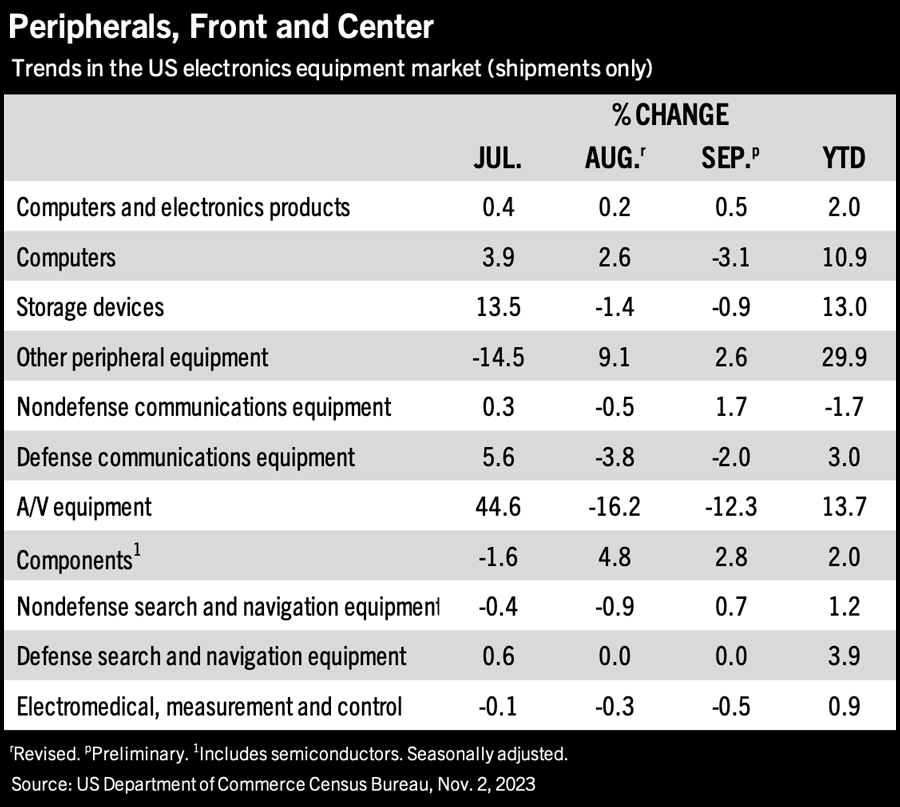IDC: Semi Market Begins Return to Growth
SAN MATEO, CA – The semiconductor market has hit bottom and has begun a return to growth that will accelerate next year. That’s according to IDC, which in November raised its September revenue outlook to $526.5 billion from $518.8 billion. Similarly, the market research firm lifted its 2024 outlook to $632.8 billion from its previous forecast of $625.9 billion, citing US market demand resiliency and a recovery in China by the second half of 2024.
IDC sees better semiconductor growth visibility as the long inventory correction subsides in two of the largest market segments: PCs and smartphones. Automotive and Industrials elevated inventory levels are expected to return to normal levels in the second-half 2024 as electrification continues to drive semiconductor content over the next decade. Technology and large flagship product introductions will drive more semiconductor content and value across market segments in 2024 through 2026, including the introduction of AI PCs and AI smartphones next year and a much-needed improvement in memory ASPs and DRAM bit volume.
Wafer capacity pricing will remain flat next year as foundry suppliers gradually improve utilization rates and demand returns from their core fabless customers. CapEx is expected to improve as well as revenue shipments match end demand and regional Chips Act incentives stimulate investment across the supply chain.
Still, 2023 semiconductor revenue will be down 12% year-over-year before rebounding 20.2% in 2024.
“Revenues will continue to recover gradually and accelerate in 2024,” said Mario Morales, group vice president, IDC. “The semiconductor market reached a bottom and has begun to grow on a quarter-over-quarter basis. ASPs are improving in DRAM, which is a good early indicator and IDC expects suppliers will continue to control capacity additions and utilization rates to drive a sustainable recovery. Accelerating demand for AI servers and AI-enabled end point devices will drive more semiconductor content in 2024-2026 fueling a new upgrade cycle across enterprises. We expect that by the end of our forecast period, AI silicon will account for almost $200 billion in semiconductor revenues.”



Hot Takes
Japan’s PCB output has shrunk for 10 consecutive months and continues to fall into double-digit declines, with August representing the third-largest decline this year. (Japan Electronics Packaging Circuits Association)
Electronic sales are predicted to register a robust 22% quarter-over-quarter increase in the fourth quarter, adding to 7% growth posted in Q3 2023. (SEMI/TechInsights)
Worldwide tablet shipments posted a decline of 14.2% year-over-year in the third quarter, totaling 33.2 million units. (IDC)
Taiwanese electronic component manufacturers reported an industrial output of NT$1.38 trillion in October, declining 11.95% year-on-year, as demand for chips softened and clients digested inventories, limiting business for local suppliers of chips, printed circuit boards and Ajinomoto build-up film, or ABF, substrates. (Taiwan Ministry of Economic Affairs)
Worldwide silicon wafer shipments decreased 9.6% quarter-over-quarter to 3.01 billion sq. in. in the third quarter, a 19.5% drop from the 3.74 billion sq. in. recorded during the same quarter last year. (SEMI Silicon Manufacturers Group)
Worldwide smartphone shipments declined 0.1% year-over-year to 302.8 million units in the third quarter. (IDC)
Global shipments of notebooks are expected to fall 10.2% from a year ago to 167 million units in 2023. With inventory pressures easing, however, shipment volume is forecast to rise 3.2% to 172 million units in 2024. (TrendForce)
Half of Japan’s PCB market is produced in Japan, followed by the Chinese mainland and Southeast Asia (Thailand, Vietnam). By contrast, just 2% of South Korea’s PCB are manufactured domestically, as its major manufacturers switch focus from HDI to BT carrier boards. (TPCA) ![]()


